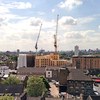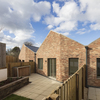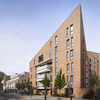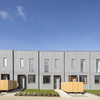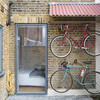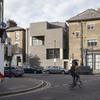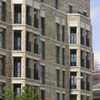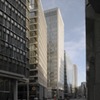Pocket Housing
Subscribe now to instantly view this image
Subscribe to the Architects’ Journal (AJ) for instant access to the AJ Buildings Library, an online database of nearly 2,000 exemplar buildings in photographs, plans, elevations and details.
Already a subscriber? Sign in
Juxon Street elevation
Sarah J Duncan Download Original
HKR has designed affordable housing in south London using offsite construction processes.
Designed by HKR Architects for developer Pocket Living, two adjacent blocks on Juxon Street and Sail Street use a modular steel unit system manufactured by Vision Modular at a factory just outside Bedford. Vision Modular’s rigid structural steel-framed box is delivered complete with windows, doors, insulation, plumbing, wiring and ducting. The only significant site work is the pouring of the concrete floor. This cuts on-site construction time by 30 per cent, and creates less disruption, with 60 per cent fewer trucks and a massive 90 per cent reduction in on-site waste.
The Sail Street block runs parallel to the main railway viaduct serving Waterloo, with its entrance at the north end, off Lambeth Road. The other block has a slight L-shape, its entrance on its western flank off Juxon Street. Along the western flanks of both blocks are access galleries, faced in perforated metal grilles. These make for robust but relatively refined façades, appropriate on the Sail Street block, which faces directly on to the railway tracks. The access gallery effectively provides an acoustic and visual threshold. This is flipped at the top, fourth-floor level. The flats here are lifted clear, accessed off an eastern gallery and enjoying extensive views to the west.
The scheme took two underused infill sites and managed to better integrate the existing residential estate with the urban context. This was achieved by using the new buildings to enclose the existing amenity space while providing contemporary street frontages on to the adjacent streets.
Using BIM greatly facilitated the manufacture process. HKR was able to directly share and develop building models with the fabrication team, testing buildability, co-ordination, and improving cost certainty and programme.
The off-site construction is achieved via a controlled assembly line process. The pods are completely finished internally in the factory with some final finishing occurring on site. Pods are delivered to the site with windows, doors, insulation, plumbing wiring and ducting. Upon delivery the modules are slotted into place as final services are connected.
The factory makes weathertight modules which arrive on site with all windows, doors, sanitary ware, fitted kitchens and service connections in place. The stacking of modules and effective sharing of building fabric creates the required performance specification in floors and walls between apartments. The performance of the building’s external fabric is achieved by the dressing of modules with further insulation, waterproofing, cladding materials and facings.
Data
- Begun: Mar 2016
- Completed: Mar 2017
- Floor area: 3,452m2
- Sector: Residential
- Total cost: £8.8M
- Procurement: Design and Build
- Address: Juxon Street, London, SE11 6NH, United Kingdom
Professional Team 
- Architect: HKR Architects
- Project architect: Jerry Ryan
- Client: Pocket Living
- Structural engineer: Tully De’Ath
- M&E consultant: Mendick Waring
- Quantity surveyor/cost consultant: DBK
- Project manager : Faithful + Gould
- Modular manufacturer: Vision Modular
- Project manager: Donban
- CDM: Quoin Consultancy
- Approved building inspector : Assent
- Main contractor: Donban
- CAD software used: Autodesk Revit































